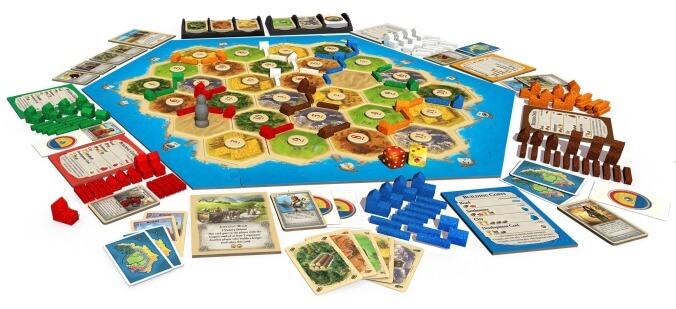25 years ago, Catan became an American hit by beating Monopoly at its own cruel game

Every Friday, A.V. Club staffers kick off our weekly open thread for the discussion of gaming plans and recent gaming glories, but of course, the real action is down in the comments, where we invite you to answer our eternal question: What Are You Playing This Weekend?
Although there are as many kinds of board games as there are meeples, dice, cards, etc., two major philosophies tend to hold sway over the hobby: American board games typically push players into direct, winner-take-all conflict that involves plenty of luck, while European-style games (Eurogames for short) focus more on cooperation—or at least less-directly hostile mechanics—with each player trying to craft a winning strategy that doesn’t necessarily require destroying their opponents. Those two seemingly disparate philosophies came together with hobby-shifting force in 1995 with Settlers Of Catan, now fresh off its 25th anniversary (complete with a shiny new anniversary edition). Catan, as it’s now titled, became the first crossover hit to bring Eurogaming styles to the U.S. But while the game has the same focus on resource gathering and lack of player elimination found in most Eurogames, its cutthroat dealings often end up just as brutal as that quintessential American board game: Monopoly.
For the unfamiliar: Players in Catan compete over land represented by hexagonal tiles laid out randomly on an island map, placing settlements in areas they control and roads to provide routes to expand to other nearby territory. Each hex produces a resource, such as brick or lumber, that can be used to build or upgrade structures and collect special cards that provide various benefits or points at the end of the game. Like turning houses into hotels in Monopoly, converting settlements into cities involves swapping out game pieces to provide a clear visual representation of whose property is the most lucrative.
Where Catan diverges from Monopoly, though (and where it cunningly twists its Eurogaming roots), is in how much power it gives players to get in the way of those lucrative moves. In Monopoly, you can see that another player is close to collecting a monopoly, but you’re not able to do anything about unless the dice land you on the right tile. In Catan, the roll of dice determines how many resources each player gains, but the increased control over how to spend those profits means you can always choose to screw your neighbor by cutting off their progress. Make a mistake early on that another player seizes upon, and you can wind up trapped in a small corner of the map with no way to expand, likely to forever remain behind in points. Essentially, Catan’s genius was in employing Eurogame mechanics in favor of a very American board game spirit.
Meanwhile, the luck involved in both games means it can be hard to get everything you want unless you can persuade your fellow players to help you—but even here, Catan’s resource-based gameplay allows far more nuance in how to be cutthroat than a simple swapping of properties. Need some ore and have plenty of sheep? You can try to offer a trade, but if other players think that’s more likely to help you than them, they can decline and force you to trade in your resources to the bank at a terrible rate of four to one. There are squares you can control to make that ratio better, but those face heavy competition from other players who also want to be masters of their own economic destiny.
Even if you try to play Catan as peacefully as possible, the game forces you into regular conflict via its Robber mechanic. Whenever someone rolls a 7, every player who’s managed to accumulate a hand of more than seven resource cards must discard half of them, and the active player gets to choose someone to steal a resource from while also rendering one of game’s tiles inert until a 7 is rolled again. (Monopoly might be mean, but it never forces players into attacking each other.) Unless you know someone has a resource you need, the Robber tends to be a way to mess with whoever’s in the lead, or just an opportunity to choose a tile that will hurt as many of your opponents as possible.
The game’s new 25th Anniversary Edition attempts to smooth over some of its most hostile edges by including the 2013 Helpers Of Catan expansion. Players can recruit various helpers that can do things like force other players to trade with them at a one-to-one rate or let you shoo the robber off your tile so you can start gathering resources again. Like playing Monopoly with a Free Parking jackpot, these cards don’t transform the game, but they do make it a little gentler.
There’s a lot to unpack about why Europeans and Americans have such different philosophies when it comes to gaming, but Catan helped push American players to broaden their horizons by meeting them on familiar ground. It also helps that even though most Americans have played Monopoly, few people seem to actually like it. “Monopoly but a little more strategic, shorter, and less cruel (sometimes)” is a pretty good pitch for someone looking to branch out from the subpar games they were raised on, and into Catan’s more robust mechanics that have served as a gateway for so many.